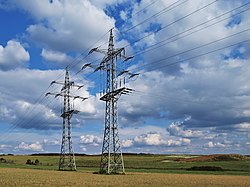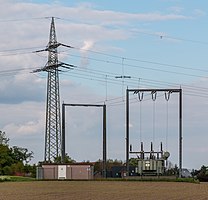Junction mast
A junction mast is an overhead line mast for the realization of a line branch . However, this branch is not always a real branch, but often a loop to create a ring line . Junction masts often, but not always, have one or more traverses across the direction of travel of the line to accommodate the branching circuits .
There are also junction masts in which the traverses of the branching circuits lie in the direction of travel of the other line if the angle of the branching lines is small. Junction masts without additional trusses are also occasionally implemented. Branch masts are almost always guy masts . For the realization of cable branches , constructions corresponding to the end masts are used. However, in the case of junction masts for cable feed, in contrast to terminal masts, the overhead line continues in both directions.
In Germany, junction masts are widespread that have two traverses that are transverse to the direction of travel of the line and over which the branching circuits run vertically from top to bottom. These are connected to those of the overhead line and led away on the lower cross member. Because of its characteristic appearance, it is also called a harp . The advantage of this construction is its high flexibility, because a looping of a circuit can be converted into a branch with relatively little effort and the choice of the circuit to be looped can also be changed if necessary.
gallery
Looping in , there is no continuous line
Web links
Individual evidence
- ↑ When masts grow into the sky , Lausitzer Rundschau from September 18, 2015, accessed on May 4, 2016



